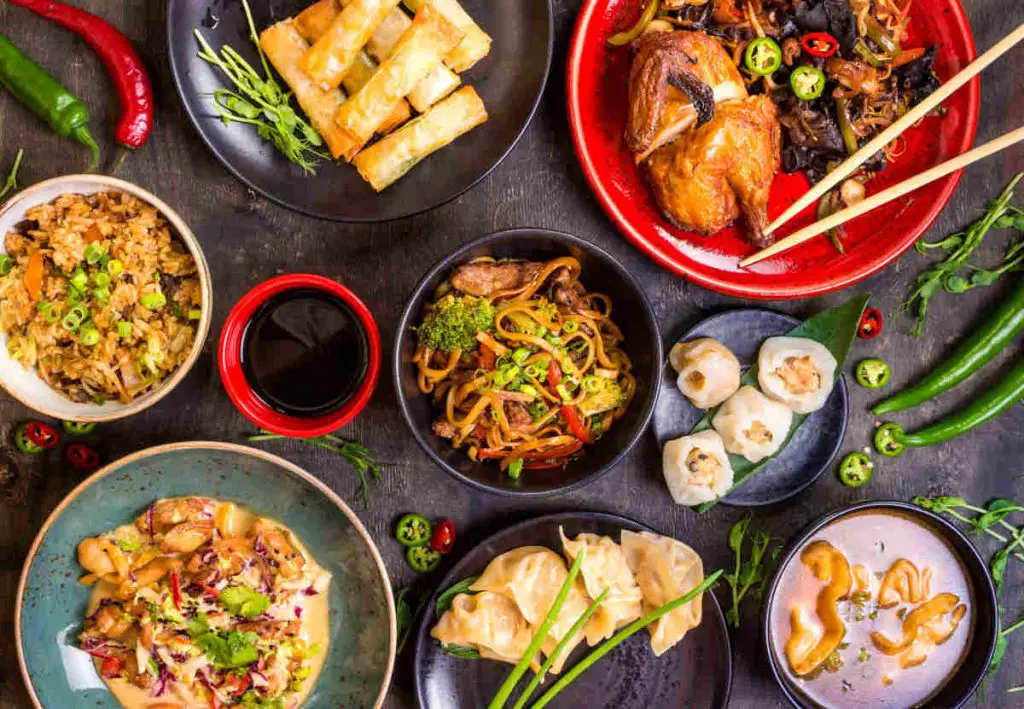
Embark on a delicious journey through China’s diverse culinary landscape! From the iconic Peking Duck of Beijing to the delicate soup dumplings of Shanghai, each region boasts unique flavors and traditions.
This comprehensive guide will unveil the secrets behind these delectable dishes and introduce you to the rich history and cultural significance of Chinese cuisine.
Signature Dishes From Each Region
| Region | Signature Dish | Key Ingredients | Flavor Profile | Cooking Technique |
|---|---|---|---|---|
| Sichuan | Mapo Tofu | Tofu, Ground Pork, Sichuan Peppercorns | Spicy, Numbing, Umami | Stir-frying, Braising |
| Cantonese | Har Gow | Shrimp, Bamboo Shoots, Rice Flour | Delicate, Savory, Sweet | Steaming |
| Beijing | Peking Duck | Duck, Hoisin Sauce, Pancakes | Crispy, Sweet, Umami | Roasting |
| Shanghai | Xiaolongbao | Pork, Gelatinized Broth, Ginger | Juicy, Umami, Tender | Steaming |
The Different Cooking Techniques Used In Each Region
| Region | Stir-frying | Steaming | Braising | Roasting |
|---|---|---|---|---|
| Sichuan | ✔️ | ✔️ | ✔️ | |
| Cantonese | ✔️ | ✔️ | ✔️ | |
| Beijing | ✔️ | ✔️ | ||
| Shanghai | ✔️ | ✔️ |
Sichuan Cuisine: A Spicy Adventure
Sichuan Cuisine is a tantalizing journey for the taste buds, known for its bold flavors and fiery spices that leave a lasting impression.
Sichuan peppercorns, also known as Sichuan pepper or huā jiāo (花椒), are the secret weapon of Sichuan cuisine. These tiny red or brown spheres pack a unique punch unlike any other spice. Forget the fiery burn of chili peppers – Sichuan peppercorns deliver a tingling numbness that dances on your tongue and creates a fascinating “mala” (麻辣) sensation. Mala translates to “numbing and spicy,” perfectly capturing the essence of Sichuan cuisine.
Sichuan peppercorns aren’t just about the numbing effect, though. They contribute a complex citrusy aroma and subtle floral notes that enhance the entire dish. Imagine biting into a juicy dumpling, the heat of the chilies building, then a wave of refreshing citrus and floral tingles washing over your palate. That’s the magic of Sichuan peppercorns!
Must-Try Sichuan Dishes
Sichuan cuisine boasts a repertoire of dishes that captivate both the senses and the soul, showcasing a perfect balance of heat, spice, and savory goodness.
- Mapo Tofu (麻婆豆腐): This legendary dish is a symphony of textures and flavors. Silken tofu bathes in a fiery red sauce buzzing with Sichuan peppercorns, minced pork, and fermented black beans. The contrasting textures of the soft tofu and the crisp vegetables create a delightful experience in every bite.
- Kung Pao Chicken (宫保鸡丁): This crowd-pleasing dish features tender chicken stir-fried with peanuts, vegetables, and chili peppers. The sweet and savory sauce, infused with the signature Sichuan peppercorn aroma, makes Kung Pao chicken a perfect balance of heat and flavor.
- Twice-Cooked Pork (回锅肉): This dish takes pork belly on a flavor journey. First, it’s braised until melt-in-your-mouth tender, then stir-fried with chili peppers, fermented black beans, and vegetables. The result is a crispy and flavorful masterpiece.
- Dan Dan Noodles (担担面): These addictive noodles are coated in a rich and spicy sesame paste sauce. Toppings like minced pork, scallions, and peanuts add layers of texture and flavor. Be prepared for a slurp-fest!
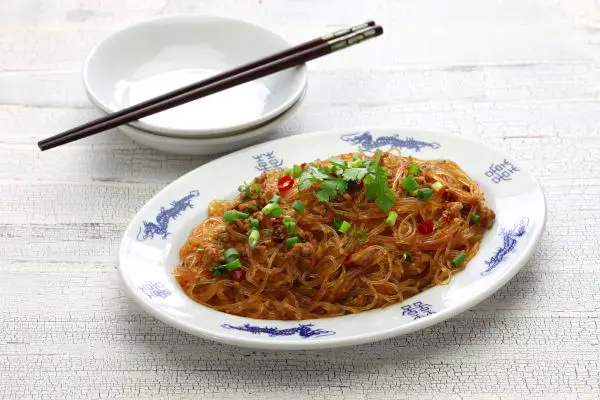
Balancing Heat and Flavor: Sichuan Cooking Techniques
Sichuan cuisine is renowned not only for its fiery heat but also for its masterful balance of flavors, creating dishes that are as complex as they are delicious. Behind this culinary magic lie a variety of cooking techniques that elevate Sichuan dishes to new heights of flavor sensation.
Mala (麻辣) : Numbing and Spicy
At the core of Sichuan cooking is the concept of “mala,” which translates to “numbing and spicy.” This unique combination of sensations is achieved through the use of Sichuan peppercorns, which impart a tingling, numbing sensation on the palate, alongside fiery chili peppers. The result is a mouthwatering dish that tantalizes the taste buds with a perfect balance of heat and numbing spice.
Guaiwei (怪味): Strange Flavor
Another hallmark of Sichuan cuisine is the concept of “guaiwei,” or “strange flavor.” This refers to the innovative blending of contrasting flavors such as sweet, sour, salty, and spicy to create dishes that are uniquely delicious and unexpected. From Mapo Tofu to Twice-Cooked Pork, guaiwei adds an intriguing depth of flavor that keeps diners coming back for more.
Xiangchun (香醇): Fragrant and Fresh
In addition to heat and spice, Sichuan cuisine also celebrates the freshness and fragrance of ingredients. The technique of “xiangchun” emphasizes the use of aromatic herbs, spices, and fresh produce to enhance the natural flavors of each dish. From the delicate aroma of fresh ginger to the fragrant notes of garlic and green onions, xiangchun adds a refreshing dimension to Sichuan cuisine that delights the senses.
Culinary Innovation
While traditional Sichuan cooking techniques form the foundation of the cuisine, modern chefs continue to push the boundaries of flavor with innovative approaches and creative reinterpretations of classic dishes. Whether it’s incorporating new ingredients, experimenting with cooking methods, or fusing Sichuan flavors with international cuisines, culinary innovation ensures that Sichuan cuisine remains vibrant and exciting in an ever-changing culinary landscape.
Mastering the art of balancing heat and flavor is no easy feat, but in the hands of skilled Sichuan chefs, it transforms ordinary ingredients into extraordinary culinary creations that are sure to leave a lasting impression.
Related reading: “10 Most Important Chinese Cuisine Cooking Methods“
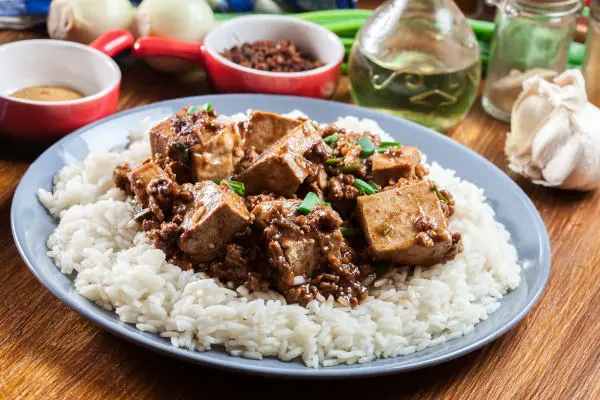
Sichuan Hot Pot: A Social and Flavorful Experience
Sichuan cuisine isn’t just about the food; it’s about the experience. And there’s no better embodiment of this than Sichuan Hot Pot (麻辣火锅; má là huǒ guō). As mentioned in the article about Hot Pot, this communal dining experience brings people together around a simmering pot of boiling broth, where everyone cooks their favorite ingredients at the table.
The centerpiece of Sichuan Hot Pot is the bubbling broth, a fiery concoction simmered with Sichuan peppercorns, chilies, aromatics, and spices. The level of spice can be adjusted to suit everyone’s preferences, creating a personalized heat experience. But the real fun lies in the vast array of ingredients you can choose from:
- Thinly sliced meats: Beef, lamb, and pork are popular choices, quickly cooked in the broth for a tender and flavorful bite.
- Seafood: Shrimp, fish balls, and squid add a delightful variety of textures and tastes.
- Vegetables: From leafy greens like bok choy to mushrooms and straw mushrooms, the options are endless and ensure a well-rounded meal.
- Tofu and Bean Products: Silken tofu, firm tofu, and fried tofu puffs soak up the flavorful broth, adding a satisfying textural contrast.
- Noodles and Dumplings: These starchy options are perfect for soaking up the delicious broth and filling your belly.
The beauty of Sichuan Hot Pot lies in its interactive nature. You cook your chosen ingredients at your own pace, creating a personalized dining experience. As you dunk your ingredients in the broth, the conversation flows, making it a perfect setting for catching up with friends and family.
The heat from the broth not only adds a layer of flavor but also creates a sense of excitement and shared experience. It’s a culinary adventure where everyone participates, making Sichuan Hot Pot a truly unforgettable dining experience.
For more information about traditional Sichuan dishes, cooking techniques, and regional specialties, you can visit Sichuan Cuisine.
Cantonese Dim Sum Delights
Dim Sum, a delightful parade of small, steamed dishes, is a cornerstone of Cantonese cuisine. It’s more than just a meal; it’s a social experience, a time for friends and family to gather, chat, and savor an array of culinary delights. But before you embark on your Dim Sum adventure, mastering a few Dim Sum etiquette tips will ensure a smooth and enjoyable experience.
- The Art of Ordering: Dim Sum dishes are typically served in steamer baskets or small plates, perfect for sharing. Traditionally, carts filled with steaming goodies are wheeled around the restaurant. Don’t be shy to flag down a cart and take a peek at the offerings. Once you’ve spotted a dish that tempts your taste buds, simply point or ask the server for a recommendation.
- Sharing is Caring: The beauty of Dim Sum lies in variety. With so many dishes to choose from, it’s best to order a selection to share with your dining companions. This allows everyone to try a bit of everything and experience the full spectrum of flavors.
- The Tea Ceremony: Tea is an integral part of the Dim Sum experience. A pot of hot tea is usually placed in the center of the table, and diners pour for themselves throughout the meal. If you’re unsure which tea to choose, a pot of Pu-erh tea (普洱茶) is a classic and versatile option that complements many Dim Sum dishes.
- Table Manners: Chopsticks are the primary utensils used for Dim Sum. If you’re new to using chopsticks, don’t worry! Most restaurants will provide forks upon request. Remember to avoid sticking your chopsticks directly into a communal serving dish – instead, use serving spoons or your own chopsticks to transfer food to your plate.
- Relax and Enjoy: Dim Sum is a casual and social affair. Don’t be afraid to experiment with new dishes and ask questions. The most important thing is to relax, savor the delicious food, and enjoy the company of your loved ones.

Classic Cantonese Dim Sum
Cantonese Dim Sum is a treasure trove of culinary delights, boasting a wide array of mouthwatering dishes that cater to every palate. Among the classics that grace the dim sum table, a few stand out as perennial favorites, each offering a unique blend of flavors and textures.
Har Gow (虾饺) : Har Gow, or steamed shrimp dumplings, are a hallmark of Cantonese Dim Sum and a true testament to the artistry of dim sum chefs. Encased in delicate, translucent wrappers, these dumplings are filled with plump, juicy shrimp and a hint of aromatic seasonings. The beauty of Har Gow lies in its simplicity—the focus is on showcasing the natural sweetness and brininess of the shrimp, complemented by the lightness of the wrapper.
Shumai (烧卖): Shumai, another dim sum classic, is a delightful marriage of savory pork, earthy mushrooms, and fragrant seasonings, all encased in a thin, tender wrapper. These bite-sized delights are typically topped with a garnish of bright orange roe or a sliver of carrot, adding a pop of color and flavor to each mouthful. Shumai is beloved for its comforting, familiar flavors and satisfying texture, making it a must-try for dim sum aficionados.
Char Siu Bao (叉烧包): No dim sum spread would be complete without Char Siu Bao, or BBQ pork buns—a beloved favorite that delights diners of all ages. These fluffy, pillowy buns are filled with tender, succulent slices of char siu pork, marinated in a sweet and savory sauce that imparts a rich, smoky flavor. Whether steamed or baked, Char Siu Bao is the epitome of comfort food, offering a perfect balance of sweetness, saltiness, and umami goodness.
Siu Mai (烧卖): Not to be confused with Shumai (烧麦), Siu Mai is another popular steamed dumpling. It typically features a yellow wheat flour wrapper filled with a savory combination of minced pork, mushrooms, and scallions.
Cheung Fun (肠粉): These delicate rice noodle rolls offer a delightful textural experience. Cheung Fun comes in various fillings, with shrimp, BBQ pork (char siu), and shredded scallions being popular choices. The rice noodle rolls are steamed and then bathed in a light soy sauce, creating a refreshing and flavorful dish.
Egg Tarts (蛋挞): No Dim Sum experience is complete without a sweet ending. Egg tarts feature a flaky pastry crust filled with a rich and creamy custard. The perfect egg tart boasts a slightly caramelized top and a smooth, custardy center, offering a delightful balance of textures and sweetness.
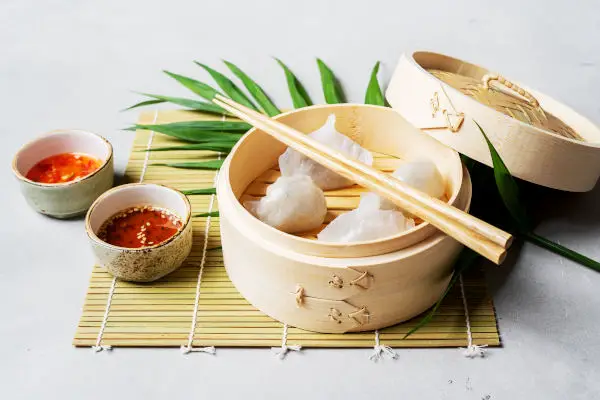
Popular Dim Sum Dishes
| Dim Sum Dish | Description | Regional Variations |
|---|---|---|
| Har Gow | Translucent rice flour dumplings with shrimp filling | Can include scallop and pork, chicken and mushroom, or vegetarian options. |
| Shumai | Steamed wheat flour dumplings with savory pork, shrimp, and vegetable filling | |
| Cheung Fun | Delicate rice noodle rolls with various fillings | Shrimp, BBQ pork (char siu), shredded scallions are popular options. |
| Siu Mai | Steamed dumplings with yellow wheat flour wrapper and savory filling | Typically includes minced pork, mushrooms, and scallions. |
Exploring Dim Sum Beyond Dumplings
While dumplings often steal the spotlight on the dim sum table, Cantonese cuisine offers a plethora of other delectable treats that are equally worthy of attention. From silky rice rolls to savory turnip cakes, exploring dim sum beyond dumplings unveils a world of flavors and textures waiting to be savored.
Let’s explore some lesser-known, but equally delicious, options that go beyond the realm of dumplings:
Rice Noodle Rolls (肠粉; Cheung Fun): As mentioned earlier, Cheung Fun offers a delightful textural experience. These steamed rice noodle rolls can be enjoyed in savory variations beyond the classic shrimp or char siu fillings. Explore options like rice noodle rolls with shredded duck, jellyfish, or even vegetarian fillings with mixed vegetables.
Turnip Cake (蘿蔔糕; Lo Bak Gou): This savory pan-fried dish is a delightful combination of textures and flavors. Grated daikon radish (turnip) is mixed with rice flour, shrimp, and Chinese sausage, then pan-fried until crispy on the outside and tender on the inside. Turnip cake is often served with a sweet chili sauce for dipping.
Phoenix Claws (凤爪; Fung Zao): This dish might be intimidating for some, but adventurous eaters are rewarded with a unique and flavorful experience. Phoenix Claws are chicken feet marinated in a flavorful sauce of soy sauce, Shaoxing wine, and spices. The collagen-rich tendons offer a satisfying chew, while the savory sauce bursts with flavor.
Related reading: “23 Chinese Cooking Utensils You Should Know“
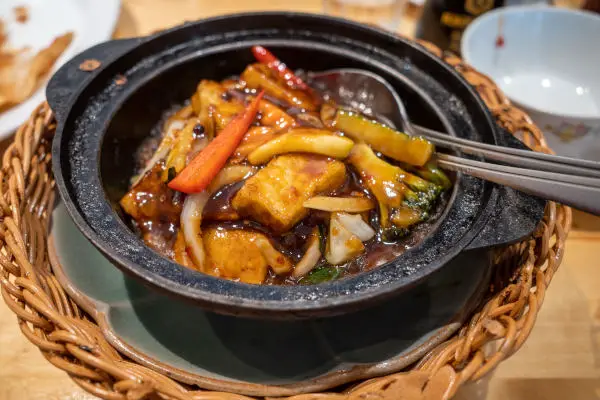
Sticky Rice in Lotus Leaf (糯米鸡; No Mai Gai): This fragrant and comforting dish features glutinous rice steamed in a lotus leaf. The rice is typically seasoned with various ingredients like Chinese sausage, mushrooms, dried shrimp, and sometimes even chestnuts. The lotus leaf imparts a subtle earthy aroma to the rice, making it a truly special treat.
Congee (粥; Jook): While not strictly a Dim Sum dish, congee is often enjoyed as a comforting and light option alongside other heartier dishes. This savory rice porridge comes in various flavors, with options like preserved egg and lean pork, chicken and mushroom, or even a simple vegetable congee.
This list merely scratches the surface of the Dim Sum universe. With its vast array of savory and sweet options, Dim Sum offers something for every palate. So next time you find yourself at a Dim Sum restaurant, don’t be afraid to venture beyond the familiar and explore the hidden gems this culinary tradition has to offer!
Popular Savory And Sweet Options Beyond Dumplings
| Dim Sum Dish | Description |
|---|---|
| Rice Noodle Rolls (Cheung Fun) | Steamed rice noodle rolls with various fillings like shrimp, BBQ pork, or vegetables. |
| Turnip Cake (Lo Bak Gou) | Pan-fried savory dish with grated daikon radish, rice flour, shrimp, and Chinese sausage. |
| Phoenix Claws (Fung Zao) | Chicken feet marinated in a flavorful sauce, offering a unique and collagen-rich experience. |
| Sticky Rice in Lotus Leaf (No Mai Gai) | Fragrant and comforting glutinous rice steamed in a lotus leaf, often seasoned with sausage, mushrooms, and dried shrimp. |
| Congee (Jook) | Savory rice porridge with various flavors like preserved egg and lean pork, chicken and mushroom, or even a simple vegetable option. |
| Egg Tarts | Flaky pastry crust filled with a rich and creamy custard. |
To explore more about Cantonese cuisine, you can check out this guidebook provided by South China University of Technology
Flavors of Beijing: Peking Duck and Beyond
In the bustling streets of Beijing, culinary treasures await at every turn, but none perhaps as iconic as the legendary Peking Duck (北京烤鸭; Běijīng kǎoya). This glistening masterpiece, with its impossibly crisp skin and succulent meat, is a testament to meticulous preparation and culinary artistry. Let’s embark on a journey, tracing Peking Duck’s path from kitchen to table.
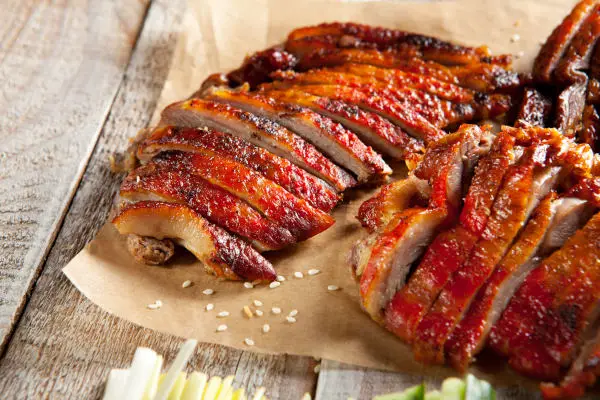
Peking Duck: From Kitchen to Table
Selection and Preparation: The journey begins with the meticulous selection of ducks. Pekin ducks, known for their plump physique and ample fat content, are traditionally used. These ducks are specially fed to ensure a layer of fat beneath the skin, crucial for achieving the signature crispness.
Air Infusion: A unique technique sets Peking Duck apart. A small pump is used to inflate air between the duck’s skin and flesh, creating a separation that allows for even cooking and maximum crispiness.
Marination and Drying: The duck is then meticulously marinated, often with a blend of spices like scallions, ginger, and various aromatics. After marinating, the duck undergoes a crucial drying process. This air-drying stage, sometimes lasting for days, helps tighten the skin further and concentrate the flavors.
Roasting: The moment of truth arrives! Peking Ducks are typically roasted in wood-fired ovens at high temperatures. The combination of high heat and the rendered fat from the duck’s skin creates a stunning mahogany-colored exterior with a shatteringly crisp texture.
Carving and Presentation: A skilled chef expertly carves the duck tableside. The glistening skin is separated first, sliced into thin, translucent pieces. The remaining meat is then carved into bite-sized portions.
Accompaniments and Enjoyment: Peking Duck is traditionally enjoyed with thin pancakes, spring onions, julienned cucumber, and a sweet bean sauce. Diners assemble their own little parcels, layering a piece of duck skin, meat, and vegetables onto a pancake, and dipping it in the sauce for an explosion of flavor and textures. The contrast between the crisp skin, tender meat, refreshing vegetables, and the sweet bean sauce creates an unforgettable culinary experience.
The Tradition: Peking Duck has been a culinary tradition in Beijing for centuries, dating back to the imperial kitchens of the Ming Dynasty. Today, it remains a symbol of Chinese culinary excellence, revered both at home and abroad for its exquisite flavors and meticulous preparation.
Here are some suggestions on Chinese cooking ingredients. – Opens in new tab.
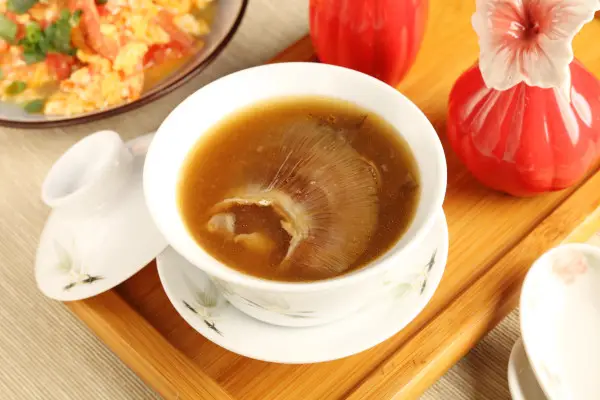
Imperial Cuisine: A Glimpse into Beijing’s Royal Culinary History
Imperial Cuisine traces its origins back to the grand halls of the Forbidden City, where the emperors of China held court and dined in splendor. Drawing inspiration from the finest ingredients and culinary techniques from across the empire, Imperial Cuisine was a reflection of the wealth, power, and sophistication of the ruling dynasty.
At the heart of Imperial Cuisine lay an emphasis on the freshest and most luxurious ingredients available. From succulent meats like Peking Duck and Braised Lion’s Head Meatballs to delicacies such as shark fin soup (鱼翅汤; Yúchì tāng) and bird’s nest soup (燕窝汤; Yànwō tāng) , no expense was spared in creating dishes fit for royalty. Exotic spices, rare herbs, and seasonal produce were meticulously sourced to elevate each dish to new heights of flavor and refinement.
The preparation of Imperial Cuisine was a meticulous process that demanded precision, skill, and artistry. Chefs in the royal kitchens underwent years of rigorous training to master the intricate techniques required to create dishes of unparalleled beauty and flavor. From the elaborate carving of fruits and vegetables to the delicate folding of dumplings and pastries, every aspect of the culinary experience was carefully curated to delight the senses and satisfy the palate.
While the days of imperial rule may be a thing of the past, the legacy of Imperial Cuisine lives on in the culinary traditions of Beijing and beyond. Today, restaurants across the city pay homage to this rich heritage, serving modern interpretations of classic dishes that honor the flavors and techniques of China’s royal kitchens. Whether dining in a luxurious banquet hall or a humble neighborhood eatery, the spirit of Imperial Cuisine continues to inspire and delight food lovers around the world.
Do you want to learn more about Chinese cuisine? Check out these cooking courses and books – Opens in new tab.
Exploring Beijing Street Snacks and Local Delicacies
Beijing’s culinary scene isn’t just about opulent Imperial dishes or the iconic Peking Duck. Venture beyond the tourist hotspots and you’ll discover a vibrant world of street food stalls and local eateries, brimming with delicious and affordable treats. Here’s a glimpse into the delightful chaos of Beijing street food:
- Jianbing (煎饼; Jiān bǐng): Considered the “breakfast of champions” in Beijing, Jianbing is a savory crepe packed with flavor. A thin mung bean flour batter is cooked on a griddle, then layered with a crispy fried egg, scallions, cilantro, and various savory sauces. Jianbing can be customized with additional toppings like ham sausage, fried dough sticks (youtiao), or even cheese for a modern twist.
- Baozi (包子): These fluffy steamed buns are a quintessential Chinese street food, and Beijing offers a delightful variety. Savory fillings like pork, lamb, or vegetables are encased in a soft and pillowy dough, making them a satisfying and portable snack. Sweet baozi with fillings like red bean paste or custard are a delicious option for those with a sweet tooth.
- Tanghulu (糖葫芦; Tánghúlu): These vibrant candied treats are a visual and culinary delight. Skewered fruits, like hawthorn berries or strawberries, are coated in a hard candy shell, creating a sweet and crunchy snack. Tanghulu is a nostalgic street food enjoyed by people of all ages.
- Dumplings (饺子; Jiǎozi): While dumplings are a staple across China, Beijing offers its own unique variations. From the classic pork and cabbage filling to more adventurous options like shrimp and chive or even lamb and scallion, there’s a dumpling flavor for everyone. They can be enjoyed steamed, boiled, or pan-fried, offering a delightful textural experience.
- Street BBQ: The aroma of sizzling meat is a common occurrence as you explore Beijing’s streets. Skewers of lamb, chicken, or vegetables are grilled to perfection, often brushed with flavorful marinades and spices. These affordable and convenient snacks are perfect for grabbing on the go.
- Douzhi (Chinese: 豆汁; dòuzhī ): This traditional fermented beverage is made from mung beans and has a tangy, slightly sour flavor that’s both refreshing and distinctive. Served cold in the summer and hot in the winter, Douzhi is often enjoyed alongside savory snacks like fried dough sticks or savory pancakes, making it the perfect accompaniment to a leisurely afternoon spent exploring the city.
This is just a taste of the vast and diverse world of Beijing street food. From savory to sweet, these delicious treats offer a window into the city’s vibrant food culture.
Related reading: Chinese Dining Etiquette and Table Manners – Opens in new tab
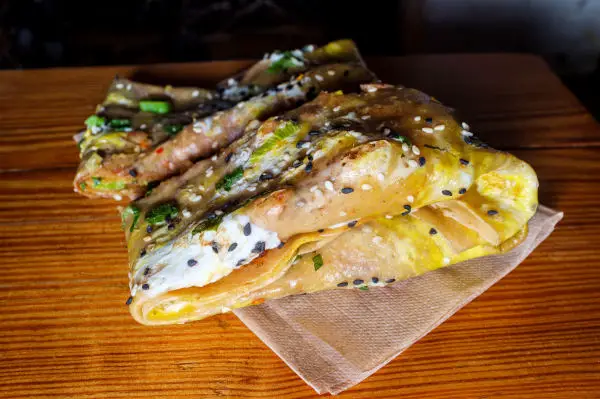
Modern Fusion in Beijing: Traditional Dishes with a Twist
While Beijing’s culinary landscape is steeped in tradition, the city’s dynamic food scene also embraces innovation and creativity, giving rise to modern interpretations of classic dishes that delight the senses and challenge the palate. Let’s explore the exciting world of modern fusion cuisine in Beijing and discover the unexpected twists that await.
Peking Duck Pizza: A Fusion Delight
One of the most intriguing examples of modern fusion cuisine in Beijing is the Peking Duck Pizza—a creative reinterpretation of the city’s most iconic dish. This inventive dish combines the crispy skin and succulent meat of Peking Duck with the cheesy goodness of pizza, resulting in a tantalizing fusion of flavors and textures that’s as unexpected as it is delicious. Topped with hoisin sauce, spring onions, and thinly sliced cucumbers, Peking Duck Pizza offers a playful twist on a beloved classic that’s sure to leave diners craving more.
Sichuan Spicy Chicken Tacos: East Meets West
Another standout example of modern fusion cuisine in Beijing is the Sichuan Spicy Chicken Tacos—a bold and flavorful mashup of Chinese and Mexican flavors. Tender strips of chicken are marinated in a fiery blend of Sichuan spices and chili peppers before being tucked into soft tortillas and topped with crunchy slaw, tangy salsa, and creamy avocado. The result is a mouthwatering fusion of heat, spice, and freshness that’s as addictive as it is satisfying.
Beijing Style Ramen: Noodles with a Chinese Twist
For noodle lovers, Beijing Style Ramen offers a tantalizing fusion of Japanese and Chinese culinary traditions. This modern take on the classic Japanese dish features chewy noodles swimming in a rich, flavorful broth made with Chinese spices and aromatics. Topped with tender slices of char siu pork, marinated bamboo shoots, and a perfectly cooked egg, Beijing Style Ramen is a comforting and satisfying meal that bridges the gap between East and West.
For valuable insights into Beijing’s rich culinary heritage, including Peking Duck and imperial cuisine, you can visit the website of the page about Beijing Cuisine from china.org.
The Rich Culinary Heritage of Shanghai
Shanghai, a bustling metropolis nestled along the banks of the Huangpu River, boasts a rich culinary heritage that reflects the city’s vibrant history and diverse cultural influences. At the heart of Shanghai’s culinary scene lies Shanghainese cuisine, a gastronomic delight characterized by its harmonious blend of sweet, salty, and umami flavors.
This delightful balance is achieved through a variety of techniques and ingredients:
- Fresh Local Seafood: Shanghai’s proximity to the East China Sea allows for an abundance of fresh and high-quality seafood. Classic Shanghainese dishes like hairy crab ( 大闸蟹, dazhu xie), stir-fried river prawns (hexi xiahu), and steamed whole fish are testaments to the region’s love for these ingredients.
- Braising and Red Cooking: These techniques are hallmarks of Shanghainese cuisine. Meats and vegetables are slowly braised in a flavorful broth infused with soy sauce, rice wine, and sugar, resulting in dishes with a rich and complex flavor profile. Examples include braised pork belly (红烧肉, hongshao rou) and red braised lion’s head meatballs (狮子头, shizi tou).
- Sweet and Savory Combinations: A defining characteristic of Shanghainese cuisine is the interplay of sweet and savory flavors. Sugar is often added to savory dishes in small amounts, creating a subtle sweetness that enhances the umami richness of other ingredients. This balance can be found in dishes like stir-fried eel with scallions (yuxiang chunyu) or pan-fried pork buns (生煎包, shengjianbao).
- Importance of Soup: Soup plays a significant role in Shanghainese cuisine. Clear broths made with ingredients like chicken, pork, or vegetables are often served alongside meals to cleanse the palate and aid digestion.
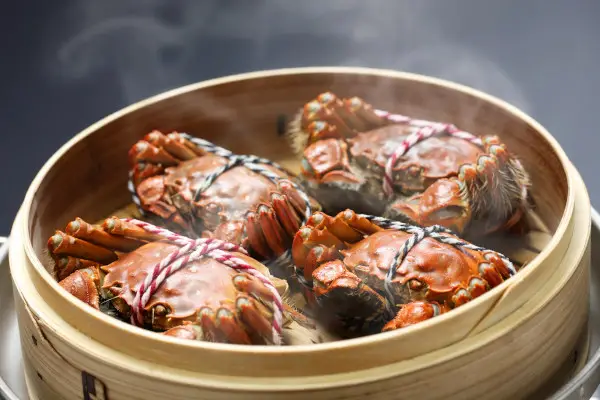
Shanghai’s Famous Xiaolongbao: Soup Dumplings Unveiled
Shanghai’s culinary scene boasts a treasure trove of delectable dishes, but none are as iconic as the Xiaolongbao (小笼包), also known as soup dumplings. These delicate parcels, filled with a flavorful broth and savory pork filling, are a true testament to Shanghainese culinary artistry.
Let’s unveil the secrets behind these delectable morsels:
The Art of the Dough: The foundation of a perfect Xiaolongbao lies in its translucent dough. Made with wheat flour, water, and a touch of fat, the dough must be thin and elastic enough to hold the flavorful broth without breaking. Skilled chefs achieve this by meticulously kneading and rolling the dough, creating a wrapper that’s both delicate and sturdy.
The Savory Filling: Traditionally, Xiaolongbao is filled with a mixture of ground pork, spring onions, and a rich gelatinous broth made from pork aspic. This aspic, made by simmering pork bones and skin, adds a luxurious texture and depth of flavor to the broth. Modern variations might include fillings like crab meat, shrimp, or even vegetarian options.
The Secret of the Broth: The magic of Xiaolongbao lies in the flavorful broth encased within. This broth is a result of meticulous preparation. Chefs meticulously simmer pork bones, vegetables, and aromatics, extracting their essence to create a clear and intensely flavorful broth. The aspic, when it melts upon steaming, further enriches the broth, creating an explosion of flavor with every bite.
The Steaming Process: Xiaolongbao are traditionally steamed in bamboo baskets, allowing for even heat distribution and gentle cooking. This process ensures that the dough remains soft and translucent while the broth reaches the perfect temperature.
The Art of Savoring: Eating a Xiaolongbao is an experience in itself. Start by carefully picking up the dumpling with chopsticks, using a spoon for extra support. Take a small bite, creating a hole to allow the broth to cool slightly. Then, savor the delicate interplay of textures and flavors – the soft dough, the savory filling, and the rich and comforting broth.

Traditional vs. Modern: The Culinary Evolution in Shanghai
Traditional Shanghainese cuisine pays homage to the city’s rich culinary heritage, with dishes that have been passed down through generations and cherished for their timeless flavors and techniques.
Staples like Sheng Jian Bao (pan-fried pork buns), Lion’s Head Meatballs, and Braised Pork Belly are beloved classics that evoke a sense of nostalgia and comfort, transporting diners back to a bygone era of traditional home cooking and family gatherings.
While traditional cuisine forms the backbone of Shanghai’s culinary identity, modern chefs are embracing innovation and pushing the boundaries of tradition to create new and exciting flavor experiences.
From experimental fusion dishes that blend Chinese and Western influences to innovative cooking techniques that elevate familiar flavors to new heights, Shanghai’s dining scene is a hotbed of creativity and experimentation.
One of the most notable trends in Shanghai’s culinary evolution is the rise of fusion cuisine, which seeks to blend diverse culinary traditions and ingredients to create bold and unexpected flavor combinations.
Whether it’s a modern twist on a classic dish or a completely new creation inspired by global culinary trends, fusion cuisine reflects Shanghai’s status as a global city where cultures converge and creativity thrives.
As awareness of environmental and health issues grows, Shanghai’s dining scene is also evolving to embrace sustainability and wellness. From farm-to-table restaurants that prioritize locally sourced ingredients to vegan and vegetarian eateries that cater to health-conscious diners, there’s a growing emphasis on mindful eating and sustainable dining practices that reflects a shift towards a more holistic approach to food and nutrition.
Related reading: “Basic Chinese Food Ingredients You Should Know To Start Chinese Cooking“
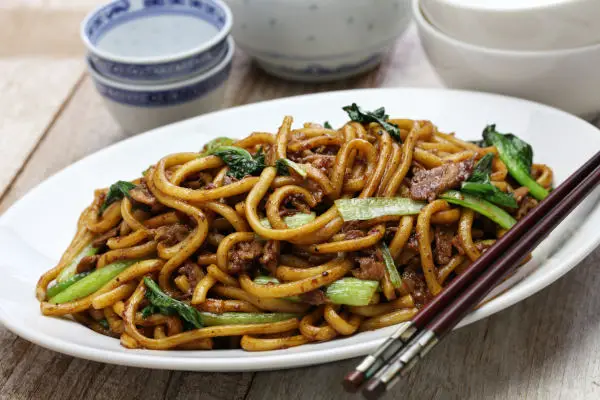
Shanghai’s Sweet Tooth: Desserts and Sweets
Shanghai’s culinary scene isn’t all savory delights. The city caters to those with a sweet tooth as well, offering a delightful array of traditional desserts and modern innovations. Let’s tantalize your taste buds with a glimpse into the sugary side of Shanghai:
- Tangyuan (汤圆; Tangyuan): These sweet rice balls are a symbol of reunion and happiness. They are typically filled with black sesame paste, red bean paste, or peanut butter, then boiled and served in a warm, sweet broth. Tangyuan are especially popular during the Lantern Festival, but can be enjoyed year-round.
- Scallion Pancakes (葱油饼; Cong You Bing): While savory scallion pancakes are a popular street food, there’s also a sweet version for those with a craving. These pancakes are filled with a sugary paste made with brown sugar and sesame seeds, creating a delightful contrast of textures and flavors.
- Red Bean Buns (红豆包; Hong Dou Bao): These fluffy steamed buns are a classic Shanghainese dessert. The sweet red bean paste filling offers a delightful counterpoint to the soft and pillowy dough. Red bean buns are a satisfying and affordable treat, perfect for a quick snack or an afternoon pick-me-up.
- Sesame Balls (芝麻球; Zhi Ma Qiu): These deep-fried sesame balls are a popular treat throughout China, and Shanghai is no exception. They are made from glutinous rice flour and filled with a sweet black sesame paste. The exterior is coated with sesame seeds, creating a satisfying crunch.
- Egg Tarts (蛋挞; Dan Tart): These flaky pastries filled with a rich and creamy custard are a legacy of European influence in Shanghai. While similar to their Portuguese counterparts, Shanghainese egg tarts often have a slightly sweeter custard and a crispier crust.
- Modern Dessert Trends: Shanghai’s dessert scene is embracing international trends as well. From French macarons and Japanese mochi to elaborate ice cream creations, there’s something for every sweet tooth to explore. High-end pastry shops and cafes are offering artistically plated desserts that are as pleasing to the eye as they are to the palate.
- Fruity Delights: Fresh fruits are a popular dessert option, especially during the summer months. Watermelon, sliced mango with sticky rice, and chilled grapes are refreshing and light ways to end a meal.
To discover more about Shanghai Cuisine, you can visit the page about Shanghai Cuisine from china.org.
End Words
As our journey through China’s culinary diversity comes to an end, we’re left with a deep appreciation for the richness and complexity of Chinese cuisine. From the bold flavors of Sichuan to the subtle nuances of Shanghainese desserts, each region offers a unique culinary experience that is as diverse as the landscapes that shape it.
As you venture forth into your own culinary adventures, may you savor every bite and relish in the joy of discovering new flavors, traditions, and stories that enrich our shared culinary heritage. Until our next culinary escapade, may your tables be filled with laughter, love, and the delicious flavors of China’s regional delicacies.
Do you want to learn more about Chinese cuisine? Check out these cooking courses and books – Opens in new tab.
Stay in Touch
 Join our newsletter by using the forms on this website or click here!
Join our newsletter by using the forms on this website or click here! Follow us on Google News
Follow us on Google News Follow us on Facebook
Follow us on Facebook
Feature Image from Depositphotos



